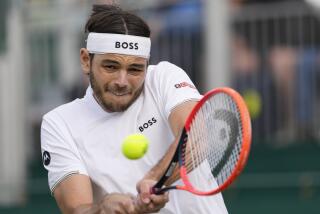KEEP OFF the GRASS
- Share via
WIMBLEDON, England — They really care about grass around here. They care so much that lawn mowing is supervised, that specks of mud are flicked by hand off emerald turf, that people stand around and watch grass grow.
So, imagine the clash when hundreds of brawny construction workers armed with shovels, jackhammers, backhoes, dump trucks and cranes met the All England Lawn Tennis & Croquet Club, home of the world’s most prestigious tennis tournament, Wimbledon.
For three years, the workers carefully prowled the grounds like bulky ballet dancers as they erected an 11,432-seat stadium--a new Court 1 that opens when this year’s tournament begins Monday.
They had to make sure dust didn’t fly all over the place as they leveled a hillside of clay.
They had to hide their tracks and suspend work when the tournament was played.
But most of all, they had to keep off the grass that was hauled from the north of England and planted in a concrete tray inside the partially built stadium in September 1995.
What were the consequences of a worker nicking a blade of grass?
“Appalling penalties,” said Richard Rees, the project’s design team leader from the London architectural firm Building Design Partnership.
“If they let the crane even pass across the top of the grass, they were fired on the spot,” he said. “A few crane operators were not very long-living around here.”
But the grass survived. And the stadium was built.
Now, Wimbledon nervously awaits the first divot.
There’s a lot riding on Court 1, which is supposed to help bring Wimbledon into the late 20th century. There’ll be more seats--and elbow room--for spectators. For years, tromping around Wimbledon’s packed courts was often as comfortable as a New York subway train at rush hour.
“We wanted to try and spread the fans, the crowd, evenly across our grounds,” said Christopher Gorringe, the All England Club’s chief executive.
Court 1 is billed as the “younger brother” of Centre Court, the gorgeous stadium opened by King George V in 1922 and used to crown the great tennis champions. The old Court 1 was simply tacked on to the side of the main stadium.
But it was at Court 1 that Wimbledon could be reached out and touched by common fans who sat on benches in a bandbox. It was where John McEnroe once raged at an umpire, “You are the pits of the world.” And it’s where Allied soldiers celebrated victory by playing tournaments in the summer of 1945.
The place still stands partially demolished, like a ghost of tennis past. Most of the seats have been ripped out. The old grass court is gone.
The new Court 1 is big, modern and commercial--sports meets a shopping mall.
There are a food court, swanky restaurant, merchandise shop and offices for tennis bureaucrats.
There are even luxury suites.
Buried beneath the stands is a transportation tunnel - a handy item for trucks, buses, plus the occasional harried tennis pro or member of Britain’s royal family. They’ll also compact trash beneath the glittering new venue.
Inside the stadium, there’s magic.
Even new, it looks like Wimbledon. Dark green seats are arrayed in the circular stadium. A 410-ton roof provides perfect summer shadows. And there’s the best stage of all, grass.
“You create tennis theater,” said Rees, a 45-year-old architect.
“There is an intimacy with stadiums at Wimbledon,” he said. “If you get much beyond 13,000 seats, you get beyond the distance of being able to see a tennis ball.”
“The roof creates shadows,” he said. “It suppresses the movement of the crowd for the players. It provides good acoustics. At Wimbledon, a burst of noise is dramatic.”
In the coming years, there will be other improvements at Wimbledon. New buildings for players, club members and the press. New outer courts. And an expansion of Centre Court.
Officials at the All England Club decline to discuss the total cost of the project. But they say improvements are funded by Wimbledon’s season-ticket holders, who purchase five-year bonds called debentures, good for five years’ worth of tickets. The prices range from some $16,000 each for 1,000 Court 1 seats to some $32,000 each for 2,100 Centre Court seats.
The debentures are usually a quick sellout.
By comparison, a more ambitious overhaul at the National Tennis Center in New York is budgeted for $234 million.
For now, everyone waits for the first Wimbledon match on Court 1. Those few club members who have tested the court say the grass is fast, supple, ready for tournament tennis.
“I don’t think the reviews will come in until the first tennis ball is struck in anger,” Rees said.
Court 1 already has been the site of one event, though.
One day last month, 9,000 fans assembled for a television show called “Songs of Praise.”
They sang church hymns.
More to Read
Sign up for Essential California
The most important California stories and recommendations in your inbox every morning.
You may occasionally receive promotional content from the Los Angeles Times.










